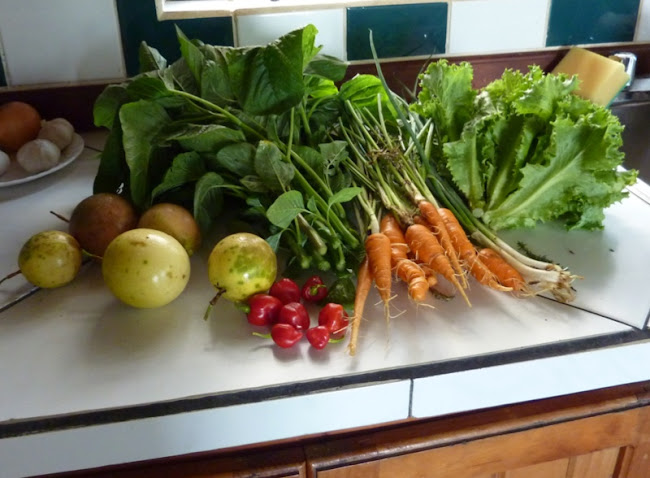 |
Gainesville Compost Chief Engineer & Inventor Steven Kanner
mixes bokashi grain into UF Krishna Lunch food waste. |
A guest post by Chris Cano
(
I ran into Chris recently at Porter's Community Garden. You can read about this at The Gainesville community behind Porter's Garden. He talked about this different type of composting, so I asked him to educate us. Thanks, Chris.)
Upon running into Ginny at Porters Community Farm, I was excited to share with her about our Gainesville Compost initiative, particularly about a new food scrap fermentation solution called bokashi which we have been experimenting with at the Porters plot.
While the Gainesville Compost initiative collects hundreds of pounds of food scraps per week, we have normally handled this by way of traditional pile composting and vermicomposting (using earthworms). Recently, we learned about the centuries' old Japanese bokashi method of composting, which uses anaerobic bacteria to ferment food scraps, thereby reducing odors, reducing the volume of waste, and preparing the scraps to be more easily digested by microbes in the soil or compost pile.
During last week's workday, while many of the volunteers planted fruit trees, we were working on another project: handling an impromptu load of approximately 1,000 pounds of cooked food from the University of Florida's popular Krishna Lunch program, which serves about 1,000 students a day on campus.
While we have handled Krishna Lunch's pre-consumer food waste for nearly a year, their post-consumer leftovers have been going to a pig farmer. On this day last week, the Krishna Lunch coordinator gave me a call with an emergency request: "We have 44 buckets of cooked food waste in buckets, is there anything you can do for us?" So we decided to help.
Our last bokashi experiment proved to be fruitful. The process, as described below, resulted in a 40-percent reduction in volume in one week, a 60-percent reduction in volume in two weeks, and a virtually odorless end product, which after one week in our compost piles has nearly decomposed completely.
To make/use bokashi:
1. Start with a grain substrate. In our case, we've collected spent grain from a local beer brewery.
2. Inoculate your grain with a culture of microorganisms commonly known as "Effective Microorganisms" or EM1. (We purchased our first batch, but now we are maintaining a culture for future use.)
3. After one week, mix the inoculated grain into a container of food scraps. We went with a ratio of around 1:10 parts grain to food scrap. Seal the container.
 |
The liquid drained from the bokashi process
is a microbe-rich soil amendment. |
4. Throughout the following week, you should drain the liquid, which can be used as a microbe-rich soil amendment. Draining the liquid helps to reduce the volume and weight of the material as well as prevent the process from going sour.
5. After a total of two weeks fermenting, open the container and you will likely notice a surprisingly odorless mix that has dramatically reduced in volume. You can apply this food scrap (which visually resembles its original state) to the garden by burying right in the soil, or to the compost pile where it will rapidly break down.
We are excited about using bokashi to improve our process. Bokashi has the potential to be a great urban composting solution (mainly because of its odor elimination), but also an amendment and soil builder for rural agriculture. In fact, we've got a waiting list of local farmers who are eager to try it.
Happy composting!
--
If you'd like to learn more about bokashi and receive updates on our progress, visit
GainesvilleCompost.comChris Cano is "Compost Experience Officer" (CEO) at Gainesville Compost, a pedal powered community compost network in Gainesville, FL, which works to turn waste into sustainable soil for the urban agriculture movement.
Green Garening Matters,Ginny Stibolt

















































